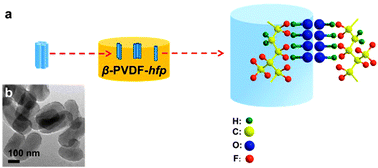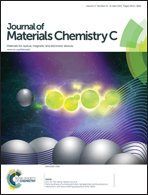β phase PVDF-hfp induced by mesoporous SiO2 nanorods: synthesis and formation mechanism†
Abstract
Poly(vinylidene fluoride) (PVDF) homopolymer and its copolymers in their β phases are the most promising polymeric materials for electroactive devices. In this work, a simple and effective strategy is developed to fabricate β-poly(vinylidene fluoride-co-hexafluoropropylene) (β-PVDF-hfp) with characteristic piezo-/ferro-electric properties using mesoporous SiO2 nanorods. The nanorods offer 2-fold arrangement for the –OH groups, namely, anisotropic rod shape and ordered mesopores. We report, for the first time in the PVDF system, the direct evidence of hydrogen bond interaction during β phase formation through XPS analysis. Our study further reveals that besides well-known facilitation by intermolecular interaction, the arrangement of surface functional groups is essential for the formation of β-PVDF-hfp. This proposed mechanism manages to explain the current controversy in the formation mechanism. We further demonstrate that our approach can be extended to a wider intermolecular interaction regime than hydrogen bonding, thus benefitting current development in PVDF homo/copolymer-based electroactive devices.


 Please wait while we load your content...
Please wait while we load your content...